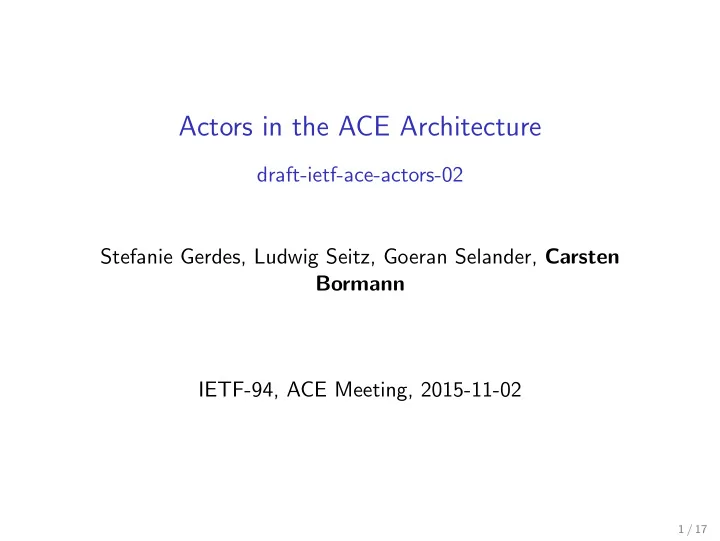

Actors in the ACE Architecture draft-ietf-ace-actors-02 Stefanie Gerdes, Ludwig Seitz, Goeran Selander, Carsten Bormann IETF-94, ACE Meeting, 2015-11-02 1 / 17
Purpose of the Actors Draft ◮ Provide terminology, the architectural elements and describe the authentication and authorization problems in constrained node networks 2 / 17
Changes in the 02-Version ◮ Addressed Jim’s Comments 3 / 17
Scenario ◮ RESTful architecture: a client (C) attempts to access a resource (R) which is hosted by a resource server (RS). ◮ C and/or RS are constrained. ◮ C and RS may not know each other, have no trust relationship. ◮ C and RS may not have the same principal (belong to the same person / company). ◮ How can principals keep the control over their data and devices? 4 / 17
Lessons Learned from the Use Cases: Security Objectives ◮ Devices handle sensitive data that needs to be protected. ◮ Different stakeholders have different security objectives. ◮ Authorization policies might change any time. Consequences: ◮ Authorization policies must be enforced by devices that send or receive sensitive data. ◮ The authorization policies must be made available to the devices to make them enforceable (in some cases dynamically). 5 / 17
Actors ◮ Actors are model -level ◮ defined by their tasks and characteristics ◮ Several actors MAY share a single device. ◮ Several actors MAY be combined in a single piece of software. ◮ for a specific application ◮ for a specific protocol ◮ Do not prematurely reduce model to one application/protocol 6 / 17
Actors in the Architecture ◮ C and RS are constrained level actors: must be able to operate on a constrained node. ◮ C and RS are controlled by principals in the physical world who specifiy security policies. C and RS must enact these policies. ◮ The less constrained nodes CAS and AS help their constrained node with authentication and authorization. 7 / 17
Lessons Learned from the Use Cases: Absent Users ◮ Often no active user at the time of access. ◮ Authorization policies cannot always be configured manually for each device. ◮ Devices often have no user interfaces and displays. Consequences: ◮ Principals will not intervene in the communication (e.g., not control the client). ◮ Principals cannot make authorization decisions at the time of access (e.g., no authorization via pop-ups). ◮ Devices must be able to enforce authorization policies on their own. 8 / 17
Benefits of Offloading Tasks ◮ There might not be an active user at the time of access. ◮ Devices often don’t have user interfaces and displays and thus cannot be controlled by the user at the time of access. ◮ One or both of C and RS are “constrained” ◮ in terms of power, memory, storage space. ◮ can only fulfill a limited number of tasks. ◮ may not have network connectivity all the time. ◮ may not be able to manage complex authorization policies. ◮ may not be able to manage a large number of keys. ◮ may not be able to precisely measure time. ◮ Address this by associating a less-constrained device to each constrained device for one or more of those difficult tasks - > Devices still have to enforce the principal’s policies on their own. 9 / 17
Lessons Learned from the Use Cases: Constrained vs Less-Constrained ◮ Limitations of the communicating devices may vary. ◮ Devices might have only some constraints (e.g., no user interface). ◮ Constrained device to less-constrained device communication is useful. ◮ Constrained to constrained communication allows for additional benefits (e.g., direct communication between the sensor and the cooling unit in the container monitoring use case enables more efficient cooling). Consequences: ◮ Constrained devices communicate among themselves as well as with less-constrained devices. 10 / 17
Constrained Level Communication: Variants ◮ Protocols must consider the limitations of their constrained endpoints. ◮ Communication protocols are still constrained level protocols. 11 / 17
Single-Domain with Single AS 12 / 17
Cross-Domain with single AS: RqP in Charge ◮ Without (R)AS, a constrained RS cannot authenticate C and validate its authorization. 13 / 17
Cross-Domain with single AS: RO in Charge ◮ Without (C)AS, a constrained C cannot authenticate RS and cannot obtain authorization policies from RqP (COP). 14 / 17
ACE Architecture ◮ Covers all variants including cross-domain settings. 15 / 17
Questions the Actors Draft deals with ◮ How do we handle authorization without an active user? ◮ How do we cope with the lack of displays and user interfaces? ◮ How do we cope with dynamic changes in a setting (e.g., outage of the communication partner (server or client), need for a replacement)? ◮ How do we consider the different security objectives of the principals on both sides? ◮ How do we combine the constrained world with the less-constrained world? ◮ How do we manage the different possible client/server settings? ◮ How can we cope with cross-domain scenarios? 16 / 17
How to proceed? ◮ Provide a summary of tasks of the various actors in the draft ◮ Use the accompanying draft about tasks for a more detailed description (see draft-gerdes-ace-tasks: comments welcome) 17 / 17
Recommend
More recommend